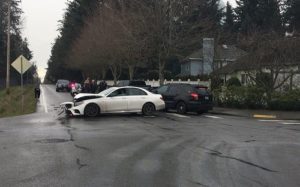Sideswipe accidents can cause serious vehicle or property damage, injuries, and even fatalities. The liable party is the person at fault for the collision. Read below as our team at American Auto Insurance explains how an insurance company determines the at-fault party in a sideswipe collision for Illinois car insurance cases.
What Is a Sideswipe Accident?

A sideswipe accident occurs when two cars collide while moving together in the same direction. Sideswipe accidents can happen when a vehicle changes lanes or merges into another lane without checking for other cars, when a distracted driver steers out of their lane, or for other reasons. They can range from minor incidents that only leave a scratch to major collisions that cause additional crashes afterward.
Who’s at Fault in a Side-Impact Car Crash?
Like most accidents, the driver responsible for causing the collision is the at-fault party. So their car insurance provider will cover the damages from the accident. Damages include all losses the other drivers and passengers involved in the collision suffered, including medical bills and property damage.
As far as car insurance goes, Illinois is an at-fault state. This contrasts with a no-fault state, where each driver’s personal injury protection (PIP) coverage pays for medical bills instead of the at-fault driver’s insurance. An insurance company will consider a driver accountable for an accident if they didn’t follow traffic rules, made a dangerous lane change, or merged with other traffic.
Passing on the Left and Right
Illinois has detailed rules about when it’s legal to pass another car, which can be relevant in sideswipe accident cases. For example, it’s illegal to pass on the left side when it involves crossing a solid yellow line, on hills or curves where you can’t see oncoming traffic, within 100 feet of a bridge or tunnel where something is blocking your view, and within 100 feet of an intersection or railroad crossing.
You also can’t pass on the left side on two-lane roadways if a school bus stops with its stop signs engaged and flashing, in a construction or roadwork zone, and in school zones of unincorporated neighborhoods.
Passing on the right usually is legal on any one-way road with two or more clear lanes to either side. It’s also legal on two-lane roads when a vehicle you’re going to pass is making a left turn or indicating an intended left turn, and at intersections expanded to allow passing on the right. Passing on the right in and out of the left lane on narrower roads when the exceptions above don’t apply could put you at fault in a sideswipe accident.
Merges and Other Special Cases
Drivers must make every attempt to merge into traffic safely. But a motorist already in that lane may be accountable for a collision if they fail to allow a car a reasonable opportunity to merge or if they don’t signal to the driver when necessary.
In rare situations, both drivers may be partially at fault in a sideswipe collision, such as when attempting to change lanes simultaneously. In such cases, their insurance companies may divide the liability between the parties. Outside variables, including weather, road conditions, or automotive problems, may occasionally cause an accident involving a sideswipe. In such circumstances, the driver might not be responsible, and the related insurance providers may split culpability.
How Is Driver Error Determined?
Careless actions are frequently the cause of a sideswipe accident. So the primary factor in determining the at-fault party involves considering whether careless behavior, especially any illegal activity, was involved. Some examples of what can cause someone to be at fault include:
- Driving while drowsy, distracted, or under the influence.
- Failing to check blind spots when changing lanes.
- Failing to signal when turning.
- Speeding or other moving violations.
- Driving at night with the car’s lights off.
- Ignoring traffic signs or signal rules.
How Does an Insurance Company Determine Fault After a Crash?
After a sideswipe or other automotive accident, some of the most crucial pieces of proof you need for your accident claim include:
- Witness statements: If another driver, passenger, or bystander saw the collision, their testimony could support your claims. If you have the opportunity, ask witnesses for their contact information.
- Police reports: Besides witness accounts, accident diagrams, and any traffic tickets issued, police reports can also include other important information concerning an accident.
- Video footage: Traffic cameras, security cameras from neighboring businesses, or dashboard cameras from another car may have recorded the area before the collision.
- Accident reconstruction: An expert accident reconstructionist may be able to put together an evidence-based recreation of how the event happened based on videos, images, crash reports, and witness accounts.
In contrast, examining the physical damage to both vehicles won’t effectively give clues to the at-fault party. Although this is a piece of the puzzle, you might need further proof to support your claim that another driver was at fault.
What Should You Do After a Sideswipe Accident?
Whether you must call the police after a sideswipe collision varies depending on the local laws. In Illinois, you legally must report any car accident by calling the police or contacting the Department of Transportation if the accident has caused death, injury, or property damage totaling over $1,500. The cost of damage is difficult to guess without expertise, but in either case, the general steps after an accident are as follows:
- Call the police.
- Provide the other driver with your contact information.
- Photograph any damage and the scene of the accident.
- Get the names and numbers of any witnesses.
To decide who was at fault for the accident, the insurance companies of both parties will examine the available data. The driver who initiated a lane change or merged into traffic may be held accountable, but there’s more nuance to some cases. If working with huge auto insurance providers has you frustrated, get a car insurance quote from American Auto Insurance. We’re knowledgeable of Illinois’s driving regulations. Contact our friendly bilingual team today by calling us at 773-286-3500 for assistance.


